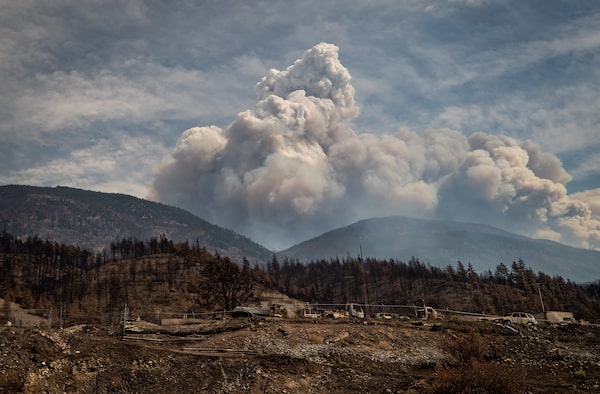
Properties destroyed by the Lytton Creek wildfire on June 30 are seen on Aug. 15, 2021.DARRYL DYCK/The Canadian Press
Extreme wildfires are increasing in frequency and intensity around the globe, and governments need to significantly bolster investments in planning and prevention, says a new UN report released Wednesday.
Driven by a combination of climate change and land-use changes, extreme fires are projected to increase by 14 per cent by the end of this decade. By the year 2030, they will increase by 30 per cent, and by the end of the century, they will increase by 50 per cent. That trend holds even if the most ambitious efforts to curb climate change are realized, according to the report titled Spreading like Wildfire: The Rising Threat of Extraordinary Landscape Fires.
“The heating of the planet is turning landscapes into tinderboxes, while more extreme weather means stronger, hotter, drier winds to fan the flames,” the report says. “Too often, our response is tardy, costly, and after the fact, with many countries suffering from a chronic lack of investment in planning and prevention.”
The joint report from the UN Environment Programme and GRID-Arendal, a non-profit environmental communications centre based in Norway, has been released ahead of a session of the UN Environment Assembly next week.
In Canada, the forecast means regions with little experience with wildfires will be at risk, said Amy Christianson, a researcher with the Canadian Forest Service and one of the report’s authors.
“Many of the projections that my colleagues have done really show that we will be seeing the same increases in Canada, especially in more northern parts of the country – in the Arctic and in the boreal forest,” she said.
As emergency supports for Lytton evaporate, B.C. starts to clear obstacles to reconstruction
B.C. budget leaves questions about its disaster recovery plan
That is already starting to happen. Wildfires in Alaska and Siberia in 2019 sparked alarm about shifting environmental conditions, and in 2020, the region experienced the worst wildfires on record.
The report’s authors include more than 50 experts from research institutions, government agencies and international organizations. They are calling on governments to adopt a new funding formula that would see two-thirds of wildfire spending devoted to planning, prevention, preparedness and recovery, with one third left for response.
Currently, direct responses to wildfires typically receive over half of related expenditures, while planning and prevention receive less than 1 per cent.
The report was released one day after the B.C. government released its budget plan which promises to be more proactive in responding to extreme weather events. It will deliver more than $200-million to local governments and First Nations communities to reduce disaster risks. The province is also making investments to improve data-gathering to help predict weather-related risks, and it is moving the B.C. Wildfire Service to year-round operations to focus on prevention and mitigation.
This comes after the summer of 2021, when the province saw a deadly heat wave that led to drought conditions and wildfires. Since 2017, British Columbia has recorded its three worst wildfire seasons on record. Last year, the province spent $565-million fighting wildfires, and the village of Lytton was consumed in a matter of minutes in one of those fires. Those fires, in turn, exacerbated the devastating floods and landslides that took place in November. The record-breaking rainstorms that month left billions of dollars of damages in their wake.
The costs of wildfires are often counted in terms of human lives and infrastructure losses, but the toll is much broader, the report notes. Exposure to smoke particulates above safe levels can cause chronic impacts that reduce life expectancy and increase pressure on public-health systems, and there is evidence that wildfires are pushing some animal and plant species closer to extinction.
“Not only can wildfires reduce biodiversity, but they contribute to a climate change feedback loop by emitting huge quantities of greenhouse gases into the atmosphere, spurring more warming, more drying, and more burning,” it says.
The report notes that wildfires can compound the impact of other weather events. After severe fires, the loss of vegetation reduces the land’s ability to act as a sponge and filter for downstream water. “Water from rainfall or snowmelt, or both, runs faster on bare, unstable ground, thereby enhancing its erosive power.”
In the report, the authors call for a combination of data and science-based monitoring systems with Indigenous knowledge. Dr. Christianson said Canada is making some progress on this front. Organizations such as the Yukon First Nations Wildfire and the Interior Salish Fire Keepers are getting involved in fire management. However, some barriers remain.
“In Canada, Indigenous people have really still been kept out of decision making about wildland fire, even when they’re involved. It’s usually more in support role,” she said.
Our Morning Update and Evening Update newsletters are written by Globe editors, giving you a concise summary of the day’s most important headlines. Sign up today.
 Justine Hunter
Justine Hunter